Other BACS Cleanroom Services
Periodic, Project-Based, Disaster Recovery
Many companies utilise scheduled maintenance periods to undertake major cleaning, refurbishment and equipment installation. BACS is able to promptly provide additional cleanroom-trained and experienced staff to perform periodic or project-based procedures beyond our standard cleaning services. This additional workforce can be especially crucial in helping return a facility to full operation in minimal time after a shutdown or disaster.
BACS other cleanroom cleaning services are available nationwide including Sydney, Melbourne, Perth, Canberra, Brisbane, Adelaide, Hobart and Darwin as well as most regional areas.
Quick Links to Other BACS Cleanroom Services
Scrub-Washing Vinyl Floors
Polyurethane-coated vinyl is a flooring type found in many cleanrooms and controlled environments. Despite regular vacuuming and damp mopping, residue from production, footwear and trolley wheels can accumulate over time. BACS scrub-washing technique safely and effectively removes any build-up and returns the floor to a clean state.
- During this process, BACS cleaners do not create additional contamination which could compromise your cleanroom.
- All equipment supplied by BACS is cleanroom-dedicated and methodically cleaned and disinfected prior to use in your cleanroom.
- BACS cleaners are trained to ensure care is always taken when using cleaning machinery inside a controlled environment.
- The floor is cleaned with a rotary polisher, low abrasion pad and cleanroom-compatible detergent.
Before
Grime build-up on the vinyl turn-up as well as stain marks from equipment that has been moved.
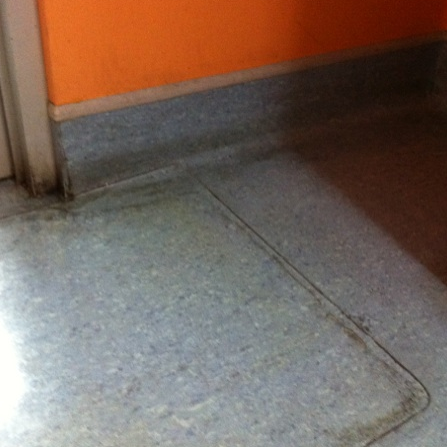
After
With the proper procedure and equipment, sealer and contamination build-up can be removed effectively.
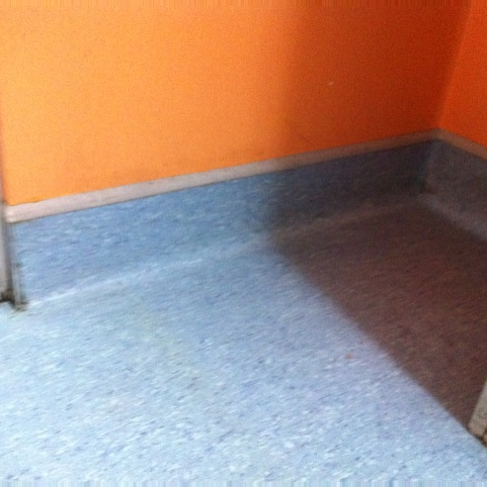
Before
Scuff marks left in sealer is a contaminant and must be removed by stripping or scrub-washing.
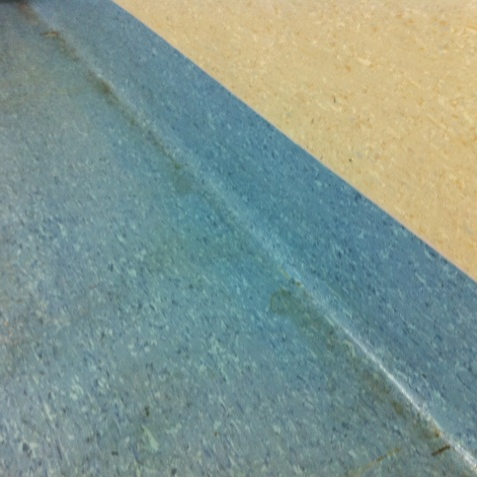
After
A cleaner floor.
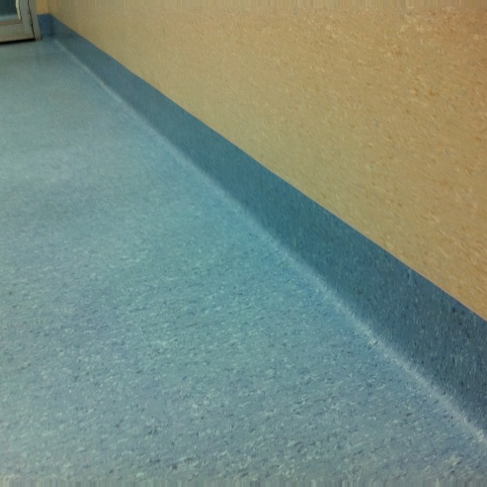
How
The floor is cleaned with a rotary polisher, low abrasion pad and cleanroom-compatible detergent. A full room decontamination / sanitisation is required after a scrub-wash or strip and seal.
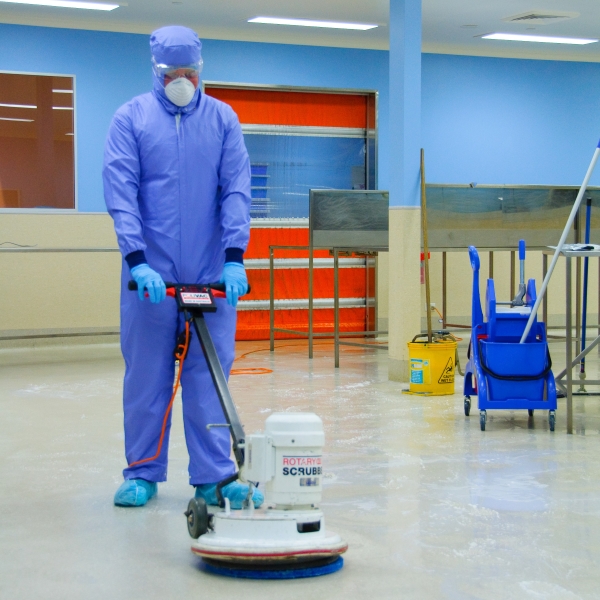
Stripping and Resealing Vinyl Floors
Certain vinyl floors require their top layer of acrylic sealer be stripped off and re-applied on a regular basis. Once the old sealer is removed and the floor is thoroughly cleaned, several coats of fresh sealer are applied. The new sealer forms a protective layer on top of the vinyl that keeps the floor easy to clean.
- BACS can recommend the best type of sealer for ongoing maintenance, including ESD (Electrostatic Discharge) safe sealers for static-sensitive environments.
- This service can be incorporated into planned maintenance during production shutdown in accordance with your SOPs.
- Using a rotary polisher and a chemical stripper, BACS cleaners strip back the old sealer and ensure that walls and equipment are left free of splash and mop marks.
- Layers of new acrylic sealer are carefully applied, leaving the floor sealed, clean and ESD-safe, where applicable.
Support and Auxiliary Area Cleaning
Areas which support a cleanroom must be cleaned periodically because of their potential to introduce contamination into a controlled environment. These auxiliary areas can include laboratories, service corridors and storage spaces for raw materials, finished goods, supplies and equipment. Power rooms, HVAC areas and even the cleanroom exterior if it is housed inside a larger room or warehouse can also be sources of contamination.
- The condition and cleaning schedule of support areas could be overlooked when considering the facility’s overall contamination control strategy.
- Experience cleaning all types of support areas means BACS can develop a protocol and schedule to maintain them in an appropriate condition.
- Because BACS cleaners are trained in cleaning the critical environments which these areas support, they can apply relevant cleaning techniques and precautions.
- BACS cleaners assess all support areas and can provide a customised Risk Assessment or Safe Work Method Statement prior to starting work.
Exterior Equipment Wipe-Down
When installing new cleanroom equipment, fixtures such as work benches and laminar flow hoods do not usually arrive in a condition clean enough to go directly into the cleanroom. Before introduction, careful detailing of all external surfaces is required to remove particulates, residue and in some cases bacteria.
- Cleanroom operators will not need to spend their time cleaning new equipment.
- Drawing upon our cleanroom experience, BACS use tried and tested procedures, equipment and chemicals to safely clean a variety of surfaces.
- BACS cleaners initially use HEPA-filtered vacuums to remove loose particulates.
- A wet wipe-down with either a cleanroom detergent or disinfectant removes residue and bacteria.
Disaster Recovery
Cleanroom disasters take many forms and their remediation varies accordingly. Post-disaster decontamination may involve removing smoke damage and condensed plastic residue from walls and floors, remediating water damage from floods, cleaning ceiling panels after fire suppressant release and clearing away other debris. Sometimes insect infestation is the problem. Other times, an event occurs such as loss of pressurisation, equipment malfunction or a drill-through which violates the cleanliness of the room.
- Whatever the nature of a disaster, BACS can help you resume normal facility operation promptly in an environmentally safe condition and meet the required cleanliness standards.
- BACS can provide a prompt response with teams available in most areas.
- To avoid safety hazards, BACS cleaners start by completing a Risk Assessment and defining procedures prior to commencing work.
- The BACS disaster recovery strategy involves the equivalent of a post-construction clean, followed by as many pre-validation cleans as are required to ensure complete removal of all contaminants.
Air Particle Testing
Routinely monitoring air quality in a cleanroom gives an indication of the effectiveness of a technical cleaning regime. Increasing particle levels can also be a sign of air filtration problems or other lapses in controlling the environment. BACS is not a certification service, but can assist you in your environmental monitoring. Our reports verify that air quality meets, does not meet or exceeds established standards. Used on a regular basis, BACS air particle reporting can serve as a useful internal benchmark.
- Using BACS to particle test saves you from purchasing a particle counter and paying annual calibration fees.
- BACS particle testing can be conducted after a cleaning service and incorporated into your routine facility maintenance plan.
- BACS testing samples points in accordance with ISO 14644 methodology and counts six particle sizes from 0.5 to 25 microns.
- After measurement, BACS provides a written report which includes a summary of recommendations, an analysis of the measurements, the actual results, a map of sampling points and an optional graphic profile that shows where the highest particle concentrations were found.
Other
During twenty years of cleaning cleanrooms, BACS has followed a wide range of SOPs. This exposure to a variety of protocols means BACS can work with you to devise a safe and effective method to clean almost any cleanroom or support area. BACS personnel includes specialists in the fields of HVAC air handling, filtration and controlled environments. Contact BACS to develop unique cleaning procedures and maintenance schedules that address your particular facility requirements and SOPs.